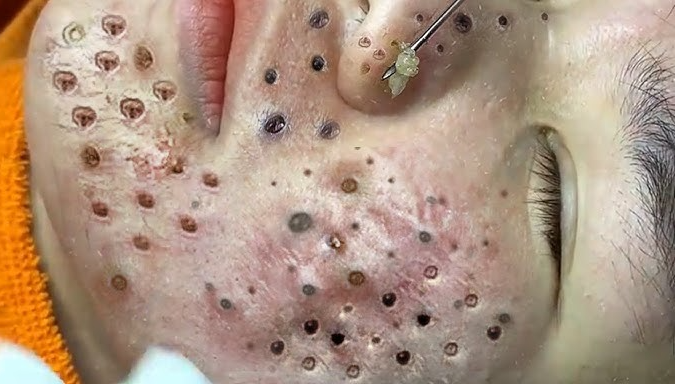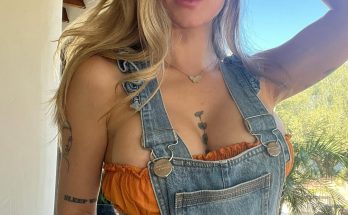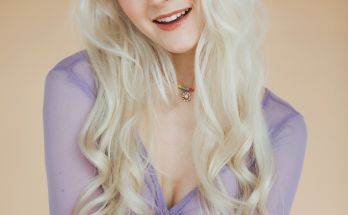
At first glance, the image presents a close-up of a face marked by blackheads, blemishes, and redness—an unfiltered portrayal of skin in its raw, untreated state. But beneath the surface lies a deeper narrative: one of vulnerability, self-care, and the intimate rituals we perform in pursuit of healing. The act of blackhead extraction, often dismissed as mundane or clinical, becomes here a moment of tactile confrontation—a dialogue between imperfection and intention.
The skin, dotted with dark spots and inflamed patches, tells a story of time, environment, and biology. It’s a living canvas, bearing the traces of stress, hormones, pollution, and perhaps even emotional strain. In this context, the blemishes are not flaws but evidence—proof of life lived, of the body’s ongoing negotiation with its surroundings.
🛠️ The Tool and the Gesture: Precision Meets Empathy
The presence of the extraction tool introduces a layer of precision and care. It’s not just a metal instrument—it’s a symbol of intervention, of the desire to restore balance. The tool’s cold, clinical nature contrasts with the warmth and sensitivity of the skin it touches. This juxtaposition evokes a tension between science and softness, between method and emotion.
The gesture—pressing the tool against the nose to release a blackhead—is intimate, almost surgical. It requires focus, patience, and a kind of quiet respect for the body’s complexity. Whether performed by a professional or the individual themselves, this act becomes a ritual of reclamation: reclaiming clarity, comfort, and confidence.
🔍 Texture and Detail: The Landscape of the Face
Zooming in on the skin’s texture reveals a landscape of pores, ridges, and discoloration. Each blackhead is a tiny crater, each blemish a raised hill. The redness around the extraction site suggests inflammation, but also the body’s responsiveness—its readiness to heal. This terrain, though imperfect, is deeply human. It resists the airbrushed ideals of beauty and instead offers a portrait of authenticity.
The nose, often central in facial composition, becomes the focal point of this image. It’s where oil glands are most active, where blackheads tend to cluster. By highlighting this area, the image draws attention to the everyday struggles of skincare—the persistence required to maintain clarity, the courage to confront discomfort.
💬 Symbolism and Emotional Resonance
Symbolically, the image speaks to themes of exposure and transformation. To show one’s blemished skin is to reveal a layer of self often hidden. It’s an act of vulnerability, but also of defiance—refusing to mask or conceal what is real. The extraction process, then, becomes a metaphor for emotional cleansing: removing what clogs, what burdens, what no longer serves.
There’s also a quiet resilience in this scene. The skin, though marked, is not defeated. It’s in the process of renewal. The redness, the pressure, the discomfort—all point to a journey of healing. This is not a moment of shame, but of care. It’s a reminder that beauty is not the absence of flaws, but the presence of intention.
🧴 Skincare as Ritual and Identity
Beyond the clinical, skincare is deeply personal. It’s how we greet ourselves in the mirror, how we prepare for the day or unwind at night. The act of blackhead extraction, though often associated with dermatology, is also a form of self-dialogue. It says: I see you. I care for you. I want you to feel better.
In many cultures, skincare rituals are tied to identity, tradition, and even spirituality. The cleansing of the face can be a symbolic washing away of the past, a preparation for renewal. In this image, the tool becomes a kind of wand—transforming the skin not through magic, but through meticulous care.
📸 Aesthetic and Cultural Context
From an aesthetic standpoint, the image challenges conventional beauty norms. It doesn’t shy away from imperfection—it magnifies it. This rawness is part of a broader cultural shift toward authenticity in visual storytelling. Social media, once dominated by filters and flawless skin, now increasingly embraces the real, the textured, the lived-in.
This image could easily belong to a skincare awareness campaign, a dermatology tutorial, or a personal blog about acne journeys. Its power lies in its honesty. It invites viewers not to judge, but to empathize—to recognize their own skin struggles and to feel less alone.
🌀 Narrative Possibilities
Imagine this image as part of a larger story. Perhaps the person has battled acne for years, trying countless products and routines. This moment of extraction is not just about clearing a pore—it’s about reclaiming agency. It’s a small victory in a long war. Or perhaps it’s a professional treatment, a step in a transformative journey toward self-acceptance.
The redness, the blemishes, the tool—all become characters in this narrative. They interact, they conflict, they resolve. And the skin, ever resilient, continues to evolve.
Would you like to explore this image through a different lens—perhaps psychological symbolism, cultural beauty standards, or even a fictional narrative from the skin’s point of view? I’d love to expand this with you.


